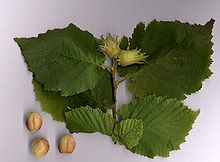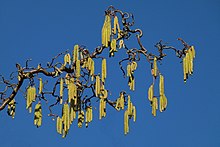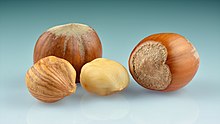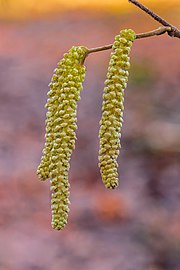Corylus avellana
| Corylus avellana | |
|---|---|

| |
| Leaves and nuts | |
| Scientific classification | |
| Kingdom: | Plantae |
| Clade: | Tracheophytes |
| Clade: | Angiosperms |
| Clade: | Eudicots |
| Clade: | Rosids |
| Order: | Fagales |
| Family: | Betulaceae |
| Genus: | Corylus |
| Species: | C. avellana
|
| Binomial name | |
| Corylus avellana | |

| |
| Distribution map | |
Corylus avellana, the common hazel, is a species of flowering plant in the
Common hazel is mainly cultivated for its nuts. The name ‘
Description
Common hazel is typically a
It is readily distinguished from the closely related filbert (Corylus maxima) by the short involucre; in the filbert the nut is fully enclosed by a beak-like involucre longer than the nut.[2]
Taxonomy
The scientific name avellana derives from the town of Avella in Italy,[5] and was selected by Linnaeus from Leonhart Fuchs's De historia stirpium commentarii insignes (1542), where the species was described as "Avellana nux sylvestris" ("wild nut of Avella").[6] That name was taken in turn from Pliny the Elder's first century A.D. encyclopedia Naturalis Historia.[7]
Distribution
Corylus avellana occurs from Ireland and the British Isles south to Iberia, Italy, Greece, Turkey and Cyprus, north to central Scandinavia, and east to the central Ural Mountains, the Caucasus, and northwestern Iran.[2][8][3]
Ecology
The leaves provide food for many animals, including Lepidoptera such as the case-bearer moth Coleophora anatipennella. Caterpillars of the concealer moth Alabonia geoffrella have been found feeding inside dead common hazel twigs.
The fruit are possibly even more important animal food, both for
The roots of C. avellana are also commonly used as the host for
Biochemistry
In 2003, the US Food and Drug Administration (
Cultivation

There are many cultivars of the hazel, up to 400 cultivars (in 2011) of C. avellana have been named.[18] The list of cultivars includes; Barcelona, Butler, Casina, Clark Cosford, Daviana, Delle Langhe, England, Ennis, Fillbert, Halls Giant, Jemtegaard, Kent Cob, Lewis, Tokolyi, Tonda Gentile, Tonda di Giffoni,[19] Tonda Romana, Wanliss Pride, and Willamette.[20] It also includes Polish hazelnuts cultivars; Kataloński and Webba Cenny.[21]
Some of these are grown for specific qualities of the nut including large nut size, and early and late fruiting cultivars, whereas other are grown as pollinators. The majority of commercial hazelnuts are propagated from root sprouts.[20] Some cultivars are of hybrid origin between common hazel and filbert.[4]
The following ornamental cultivars have gained the Royal Horticultural Society's Award of Garden Merit:-
- 'Contorta'[22] (corkscrew hazel, Harry Lauder's walking stick)
- 'Red Majestic'[23]
Uses
According to the New Sunset Western Garden Book, the European hazelnut is among the most widely grown hazelnut plants for commercial nut production.[24]
This shrub is common in many European woodlands. It is an important component of the
Hazelnuts

Hazelnuts are rich in protein and unsaturated fat. They also contain significant amounts of manganese, copper, vitamin E, thiamine, and magnesium.[25]
Common hazel is cultivated for its nuts in commercial orchards in Europe, Turkey, Iran and Caucasus. The name "hazelnut" applies to the nuts of any of the several species of the genus Corylus. This hazelnut or cobnut, the kernel of the seed, is edible and used raw or roasted, or ground into a paste. The seed has a thin, dark brown skin which has a bitter flavour and is sometimes removed before cooking. The top producer of hazelnuts, by a large margin, is Turkey, specifically the Giresun Province. Turkish hazelnut production of 625,000 tonnes accounts for approximately 75% of worldwide production.[26]
References
- . Retrieved 19 November 2021.
- ^ ISBN 0-00-220013-9.
- ^ a b Trees for Life Hazel species profile Archived 2013-03-29 at the Wayback Machine
- ^ a b Flora of NW Europe: Corylus avellana Archived 2008-05-02 at the Wayback Machine
- ISBN 0-00-219037-0
- ^ Linnaeus, C. (1753). Species Plantarum p. 998.
- ^ "LacusCurtius • Pliny the Elder's Natural History — Book 23". penelope.uchicago.edu.
- ^ Den Virtuella Floran: map
- .
- ^ Santelices, R.; Palfner, G. (2010). "Controlled rhizogenesis and mycorrhization of hazelnut (Corylus avellana L.) cuttings with Black truffle (tuber melanosporum Vitt.)". Chilean Journal of Agricultural Research. 70 (2): 204–212.
- ^ US Food and Drug Administration. (14 July 2003). Qualified Health Claims, Letter of Enforcement Discretion – Nuts and Coronary Heart Disease. Rockville, MD, USA: US Food & Drug Administration. pp. 1–4.
- PMID 12668999.
- ^ Surh, Y.-J. (2003). "Cancer chemoprevention with dietary phytochemicals". Nature Reviews Cancer. 3: 768-780.
- PMID 8105262.
- ^ Ness, A.R.; Powles, J.W.; Khaw, K.T. (1997). "Vitamin C and cardiovascular disease – a systematic review". J. Cardiovasc Risk. 3: 513–521.
- .
- hdl:10198/753.
- ^ Molnar, T.J. (2011). "Corylus.". In Kole, C. (ed.). Wild crop relatives: Genomic and breeding resources, forest trees. Springer-Verlag. pp. 15–48.
- . Retrieved 12 October 2023.
- ^ ISBN 0-333-47494-5.
- hdl:11585/552099.
- ^ "Corylus avellana 'Contorta'". RHS. Retrieved 27 September 2020.
- ^ "Corylus avellana 'Red Majestic'". RHS. Retrieved 27 September 2020.
- ^ "Hazelnut Plants". Archived from the original on 2016-03-31. Retrieved 2017-01-27.
- ^ SELF Nutrition data, Nuts, hazelnuts or filberts. Accessed 2014-08-22.
- ^ World Hazelnut Situation and Outlook, USDA 2004.
External links
 Media related to Corylus avellana at Wikimedia Commons
Media related to Corylus avellana at Wikimedia Commons- Corylus avellana - information, genetic conservation units and related resources. European Forest Genetic Resources Programme (EUFORGEN)




